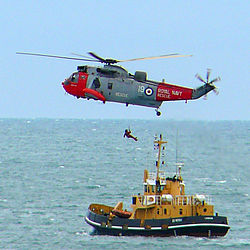
Back الإنقاذ الجوي-البحري Arabic Suche und Rettung in Luft- und Seenotfällen German Meripelastus Finnish 水難救助 Japanese Lotnicze i morskie działania poszukiwawczo-ratownicze Polish Flygräddningstjänst Swedish การกู้ภัยในทะเลทางอากาศ Thai فضائی سمندری بچاؤ Urdu


Air-sea rescue (ASR or A/SR, also known as sea-air rescue),[1] and aeronautical and maritime search and rescue (AMSAR) by the ICAO and IMO,[2] is the coordinated search and rescue (SAR) of the survivors of emergency water landings as well as people who have survived the loss of their seagoing vessel. ASR can involve a wide variety of resources including seaplanes, helicopters, submarines, rescue boats and ships. Specialized equipment and techniques have been developed. Both military and civilian units can perform air-sea rescue. Its principles are laid out in the International Aeronautical and Maritime Search and Rescue Manual.[2] The International Convention on Maritime Search and Rescue is the legal framework that applies to international air-sea rescue.[3]
Air-sea rescue operations carried out during times of conflict have been credited with saving valuable trained and experienced airmen.[4] Moreover, the knowledge that such operations are being carried out greatly enhanced the morale of the combat aircrew faced not only with the expected hostile reaction of the enemy but with the possible danger of aircraft malfunction during long overwater flights. As such, many militaries have opted to develop a capable air-sea rescue component, and ensure that such assets are available during most deployments.[4] Early air-sea rescue operations were performed by flying boats or floatplanes, with the first dedicated unit operating such aircraft being established near the final months of World War I. While initially restricted to in-shore operations and with limited equipment, capabilities and resources would be expanded over the following decades. By the start of World War II, various nations were operating capable air-sea rescue units that operated a combination of amphibious and land-based fixed wing aircraft.
Amid World War II, a major innovation was introduced in the form of the helicopter, which provided hover capabilities that were revolutionary for air-sea rescue. The first military helicopter air-sea rescue, by a Sikorsky S-51, occurred in 1946. Over the following decades, more capable rotorcraft, such as the Sikorsky SH-3 Sea King and Eurocopter HH-65 Dolphin, made longer range operations possible, with parallel advances in equipment improving both the speed and the level of help that air-sea rescue platforms could provide. The 1980s additionally saw the formal introduction of training programs for the deployment of rescue swimmers, who have proved invaluable for recovering incapacitated personnel from the sea.
Air-sea rescue operations have been prominent in several major conflicts, such as the Korean War, Vietnam War, and Falklands War. By the start of the twenty-first century, numerous civilian organizations have involved themselves in providing air-sea rescue services, in some circumstances taking over this function from incumbent military operators.
- ^ Cutler, Cutler and Wedertz 2005, pp. 36, 384.
- ^ a b "IAMSAR Manual". International Maritime Organisation. Retrieved 24 May 2022.
- ^ "Legal Brief on International Law and Rescue at Sea" (PDF). UNHCR. Retrieved 11 October 2022.
- ^ a b Cite error: The named reference
Marionwas invoked but never defined (see the help page).